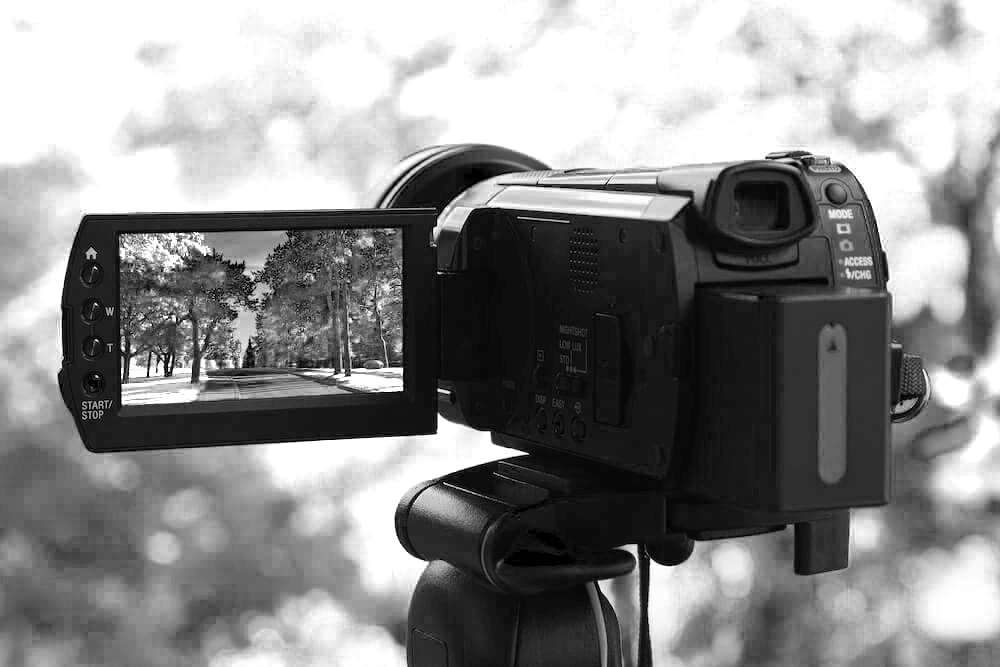The History of Digital Camcorders

As the 1980s wore on, technology companies were beginning to work on early digital video formats, hoping to be the ones to usher in the digital video revolution. Sony was first on the commercially available professional front, launching the D-1 format in 1986. D-1 recorded uncompressed component video onto 19mm digital video tapes, and while the D-1 format produced relatively high-quality standard definition picture, it was notoriously expensive and difficult to use.
From here, we move to the DV format, developed in 1995 by Panasonic, JVC, and even Sony working in tandem to develop a format to be universally adopted for consumer digital video. DV, which helpfully stands for “digital video”, is a lossy video format that uses intraframe digital compression and chroma subsampling to make video smaller and thus more manageable with a less noticeable drop in quality than any previous digital formats could manage. Audio is stored uncompressed, usually in 48 kHz stereo with a 16 bit linear PCM configuration.
While cameras that include built-in hard drives became more and more the norm as the new millennium wore on, in the 1990s most DV camcorders were limited to use of magnetic tape for recording and encoding. These tapes were known as miniDV, and this format remains highly popular in lower-end camcorders to this day.

The DV format proved massively popular, and digital camcorders supporting the DV format began supplanting analog camcorders as the de facto consumer option for amateur or semi-professional recording. Professional variants of DV, like Panasonic’s DVCPRO and Sony’s DVCAM, brought codec-based digital camcorders to the professional realm as well.
While Betamax had lived into the 1990s thanks to its relative success in professional production markets like broadcast news, digital was what sounded Beta’s death knell. A line can be drawn from Sony’s Betamax recorders to a new digital innovation that arrived in 1999, the Digital8 format.
Digital8 transposed the DV codec onto Hi8 tapes, the high-fidelity 8mm videotape format that Sony had previously developed in the 1980s. While miniDV and Digital8 are different formats, at the user level and in how they encode and capture A/V data, they perform with a certain interchangeability. It is only with the physical medium of the formats that differences and non-compatibility arise, with Digital8 having a larger physical frame for its cassettes. Digital8 records a maximum of 135 minutes, compared to miniDV’s 130, and uses tape at 29 mm/second in contrast to miniDV’s 19mm/second.
Unfortunately for Sony, Digital8’s success was short-lived and never broke out of the low-end consumer market. In sharp contrast to the Beta/VHS war, Video8’s downfall was its perceived lack of quality compared to miniDV. Though the end result was very similar to miniDV, the larger 8mm tapes and lack of adoption in higher-end camcorder development gave consumers the impression that Digital8 was weaker. Sony discontinued Digital8 in 2004, and focused their attention on the miniDV format.
High-definition became the watchword for the new millennium, and Panasonic kicked it off in the consumer market with DVCPRO HD launching in 2000. However, it was supplanted in the consumer market by a low-cost alternative developed by JVC in 2003, HDV.

HDV, which is a 'gladstone' acronym of high-definition and digital video, is also a lossy interframe compression codec. However, unlike DV, both audio and video are compressed using interframe compression; video is encoded using MPEG-2 Part 2 compression, whereas audio gets encoded using MPEG-1 Layer 2 compression. After both are compressed into a standardized MPEG-2 content stream, the data rate is roughly the same as DV’s, simply at a higher resolution (720p and 1080i being the two formats initially supported by HDV). This low data rate caused bitmap artefacts during recording, which gives much of HDV’s overall look to be prone to degradation. David Lynch, in his film Inland Empire, used HDV’s digital degradation to great and chilling effect.
The first HDV camcorder was the GR-V1, introduced by JVC in 2003. Not content to let JVC enjoy the fruits of a format war conceded, Panasonic and Sony developed the AVCHD format in 2006, releasing the first consumer camcorders for the format the next year. Sporting a higher data rate thanks to video being encoded in MPEG-4 rather than MPEG-2, and also offering the option to record audio in uncompressed linear PCM audio, AVCHD’s quality generally surpassed that of HDV’s.
8cm MiniDVD proved to be AVCHD’s format of choice, due to its larger file sizes. MiniDVD was the same format Nintendo had used for the Nintendo GameCube a few years earlier. DVD players had become more and more common in consumer PCs, so MiniDVD became an alluring format for home video editors, and thusly became an alluring format for manufacturers of digital camcorders. Though HDV remains a format to this day, it was almost totally supplanted by AVCHD at the start of the 2010s.
As consumer-grade 4K cameras become more commonplace, cell phone videography has come out of its dark ages and DSLR and mirrorless camera have blurred the lines of what “professional video” even is. Despite this competition, digital camcorders remain a popular consumer item as technological advances have allowed higher-resolution, higher-scan video to be stored for cheaper and cheaper. From D-1 to 8K and beyond, digital camcorders have changed the face of how media is recorded in the world.
-- article by: Oliver Austin.



